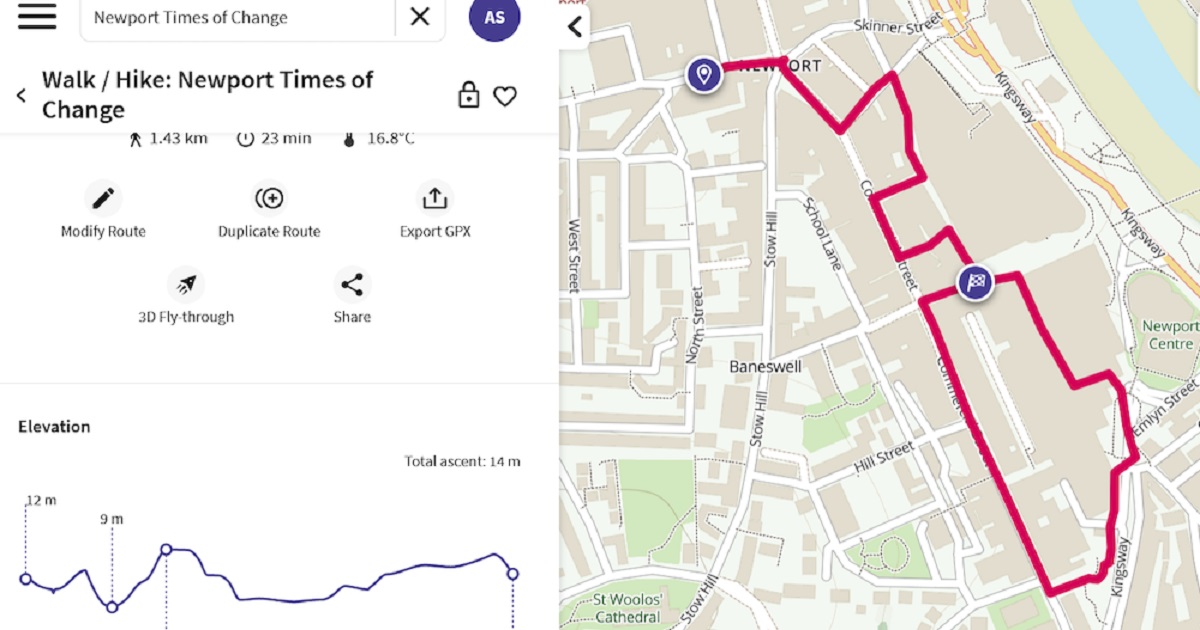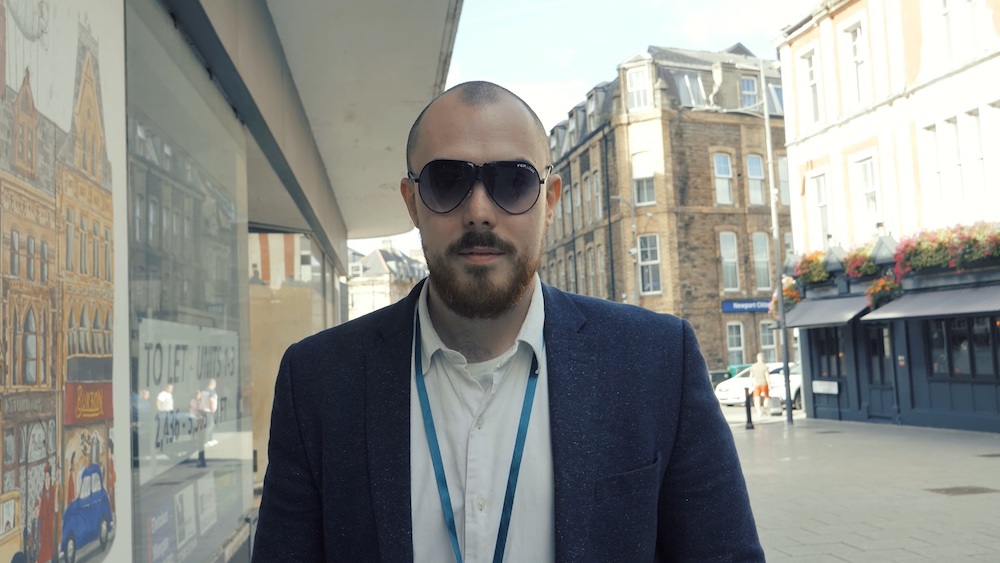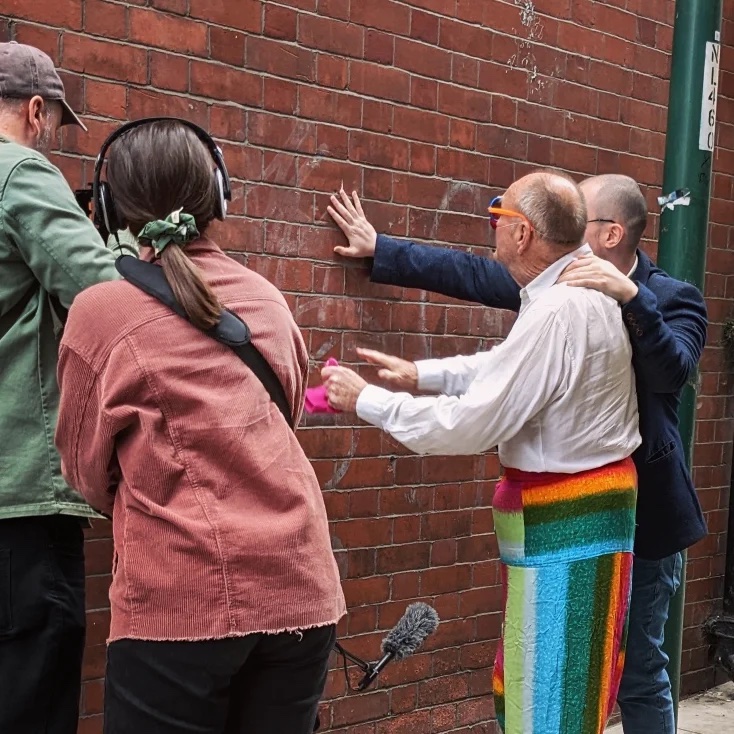Street life: a walk into Newport’s recent past

Aled Singleton
Walking and sensing the 1960s in Newport’s streets
Newport is where I am from. My parents moved there from Hampshire in the late 1970s and chose to live in a small house on the edge of the town.
As a teenager during the 1990s I went into town (as it was then) to drink average beer, watch some pretty good live music, and buy clothes that I hoped would make me more fashionable. Newport was full of concrete, car parks and connected to the wider world by the M4 Motorway.
Nothing made it remarkable compared to other places in Britain. However, my views changed when my father died in 2018 and we had to sell that small house.
I took the chance to walk around and meet people who had lived in Newport before the late 1970s. By sharing a stroll with people I found out more about the place that had shaped so much of my life.
Dramatic
This piece is about me working with performers at Tin Shed Theatre to explore life in Newport through the 1960s and 1970s. Over the summer we created dramatic interventions to represent the changes that happened in Newport nearly seventy years ago.
These were times of exciting developments such as a shopping centre, office blocks, housing estates and big bridges. We planned to meet the public on a guided walking tour on Sunday 18 September.
Unfortunately, the Queen’s death on 8 September 2022 meant that a certain mood would dominate our lives for ten days. The event planned for the day before her funeral could not happen. We used the time to step back, reflect, and use the streets to take our work in a slightly different direction.
An opening emerges from a setback
The whole world stopped to think after the Queen’s death. There was a kind of national atmosphere or shared mood.
Related to this latter idea, historian Peter Hennessey, on BBC Radio linked to an atmosphere which had lasted seven decades: namely the political consensus of post-war Britain.
The 1947-51 Labour government’s mission to rebuild Britain after World War II was largely followed by the 1951-64 Conservative government.
The early years of Elizabeth II’s reign therefore further developed the new welfare state and – crucially for my project to understand Newport – carried on renewing the urban fabric of Britain.
How did urban renewal take place in Newport?
The project with Tin Shed Theatre was about making dramatic pieces which explored interventions from the 1960s and 1970s.
We aimed to explore change which people at the time felt would make lives better. By exploring the past we found interesting parallels to contemporary crises, such as empty shops and people being made redundant.
The walk of approximately 1.4km or 1 mile long and has ten waypoints. The route can be accessed from the OS Maps Explore website.
First of all, we meet actor Matt Reed, who created a character from interviews that I had gathered in the past few years alongside materials like the newspaper cuttings.
Selling the future
A slick property developer from out of town seemingly spoke as if he was still in the 1960s. Walking along Upper Dock Street (between way points 3 and 4) he guided us towards a future of shopping centres, motorways, and bridges.
Beside him is the 15-storey Chartist Tower (see image below); built in 1967 and recently renewed as the 135-bed Mercure Hotel.
Around the corner we met a local woman born in the late 1920s and her daughter. The mother recounted stories about different streets in Newport but admitted that she couldn’t remember all the details. I reassured her that it was also healthy to also live in the present.
As the conversation ended, it was poignant that her daughter mentioned the times of prosperity in Newport when was a teenager in the late 1960s. Though present times were hard, she still hoped that ‘somebody had a secret plan.’
This brief conversation helped to reassure me of our approach: firstly, that people are keen to stop and talk; secondly, that time is complicated for all of us as memories merge no matter what age; and thirdly, that the fortunes of people and place go through ups and downs.

Developing an immersive outdoor performance
In the third example we meet Bob Pontin, who was born in the early 1940s and is a long-standing Newport resident. Bob wanted to use a clowning approach, wearing a red nose and colourful clothing, to explore the politics and history of an alleyway in Newport.
The 50-metre length of the narrow pedestrianised Friars Street acted as a portal to take us back and forward in time.
Bob Pontin chose this place (waypoint 5) as it links the Victorian-era Commercial Street through to a large area cleared in the 1960s and 1970s to build a shopping centre – erasing warehouses, a bus station, a cinema, a pub, a fire station, and other buildings.
After a playful fight to gain access, Matt guided Bob to touch the shiny red bricks.
Matt and Bob improvised as they went along and members of the public stopped to look at what they were doing. It would be great to try this out as part of a guided walk.

At the end of this short walk Bob discovered that the current shopping centre has many empty units.
Here we met the artist Temmah carrying the Little Space Gallery on her back. It is without doubt the smallest gallery in the city, if not in Wales.

The walls of Temmah’s backpack-sized art space display three press cuttings from April 1969 and maps of Newport as the streetscape changed.
On the lower shelves is a collection of brightly-painted houses – designed and made by artist Ty Dolbel to represent homes demolished nearly sixty years ago to make way for the shopping centre.
A yellow digger is placed symbolically on the floor; moving back and forward as Temmah’s body turns to invite people to peer into her little space. For example, girls working in a small shop were surprised to hear that houses used to exist on Union Street, now beneath the shopping centre car park.
We then walked through to the site of the former housing (waypoint 7). As few people were about, Temmah decided to investigate a South Wales Argus pasted up in the gallery.
The headline from 15 April 1969 told us that another ‘all-male tradition’ had gone as the president of Newport’s Chamber of Trade was to be a woman.
The film team recorded a conversation between me and Temmah as we pondered this story and a cutting from the following day.
An interview with the newly-elected Mabel Johnson revealed that she was worried that so many units in the new shopping centre on Kingsway were empty.
In many ways this echoed the state of Newport in 2022. The landlord of a pub had told us earlier on in the walk that Newport’s smaller traders were exposed by increasing energy costs.
Temmah’s walk allowed rich discussions develop from a small prompt like the newspaper or the houses and digger. As such, there is excellent potential to use this technique on a public walk with people choosing an item from inside the gallery.
What does this time travelling walk tell us?
Walking in Newport’s very much changed city centre I have been reminded that the fabric of places, whether experienced physically or through online mapping systems, open us to emotions and memories.
If there was a city-scale space at St Fagans National History Museum for a place which embraced the post-war mood of renewal, then Newport would be it.
The big concrete buildings and roads capture what was an ambition time in the 1960s and 1970s, and they remind us of what people back then wanted for the future. The newly-opened Mercure Hotel also show us that there is potential to reinvent buildings and places.
I hope that people want to follow this walking route. I would like to thank people who shared their stories, staff at Newport Reference Library (where the walk ends), and the Tin Shed Theatre team who stretched their minds and bodies to develop this material.
Aled Singleton is a geographical researcher at Swansea University and works on freelance place-based projects. You can see a film about the route and the project here.
Support our Nation today
For the price of a cup of coffee a month you can help us create an independent, not-for-profit, national news service for the people of Wales, by the people of Wales.




